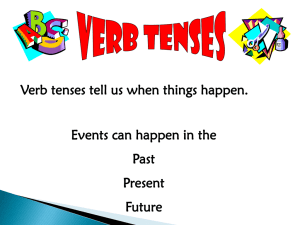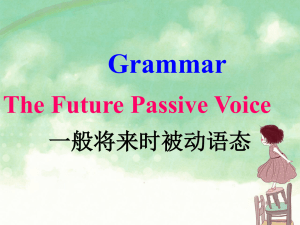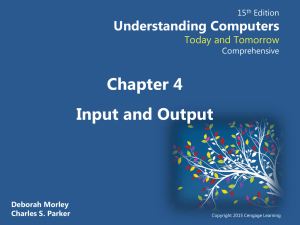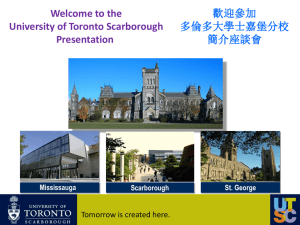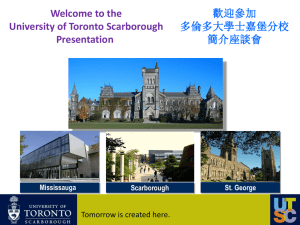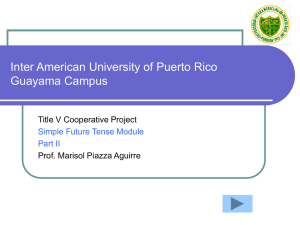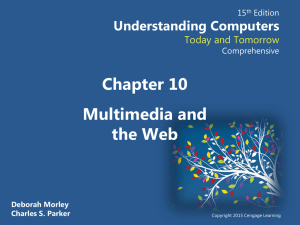morley15e__ppt_ch13 REV
advertisement
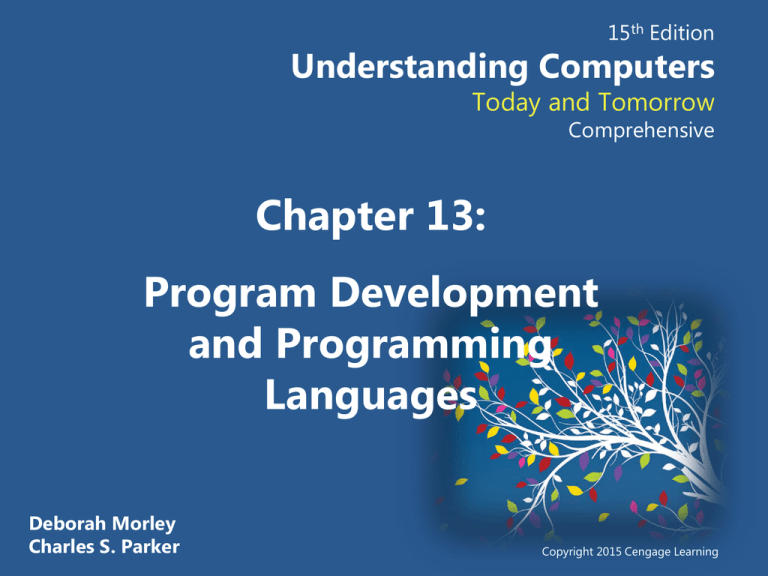
15th Edition Understanding Computers Today and Tomorrow Comprehensive Chapter 13: Program Development and Programming Languages Deborah Morley Charles S. Parker Copyright 2015 Cengage Learning Learning Objectives 1. Understand the differences between structured programming, object-oriented programming (OOP), aspectoriented programming (AOP), and adaptive software development. 2. Identify and describe the activities involved in the program development life cycle (PDLC). 3. Understand what constitutes good program design and list several tools that can be used by computer professionals when designing a program. 4. Explain the three basic control structures and how they can be used to control program flow during execution. Understanding Computers: Today and Tomorrow, 15th Edition 2 Learning Objectives 4. Discuss some of the activities involved with debugging a program and otherwise ensuring it is designed and written properly. 5. List some tools that can be used to speed up or otherwise facilitate program development. 6. Describe several programming languages in use today and explain their key features. Understanding Computers: Today and Tomorrow, 15th Edition 3 Overview • This chapter covers: – The most common approaches to program design and development – The phases of the program development life cycle (PDLC) – Tools that can be used to design and develop a program – Good program design techniques and types of program errors – Popular programming languages Understanding Computers: Today and Tomorrow, 15th Edition 4 Approaches to Program Design and Development • Procedural Programming – An approach to program design in which a program is separated into small modules that are called by the main program or another module when needed • Procedure call—locating specific tasks in procedures (modules or subprograms) that are called by the main program when needed • Allows each procedure to be performed as many times as needed; multiple copies of code not needed • Prior to procedural programming, programs were one large set of instructions (used GOTO statements) Understanding Computers: Today and Tomorrow, 15th Edition 5 Approaches to Program Design and Development • Structured Programming – Goes even further, breaking the program into small modules (Top-down design) – Variables • Named memory locations that are defined for a program • Used to store the current value of data items used in the program Understanding Computers: Today and Tomorrow, 15th Edition 6 Approaches to Program Design and Development Understanding Computers: Today and Tomorrow, 15th Edition 7 Approaches to Program Design and Development • Object-Oriented Programming (OOP) – Programs consist of a collection of objects that contain data and methods to be used with that data • Class – Group of objects that share some common properties • Instance – An individual object in a class – Inherits the attributes and methods of the class Understanding Computers: Today and Tomorrow, 15th Edition 8 Approaches to Program Design and Development • Attributes – Data that describes the object – Can be in a variety of formats • Methods – Perform actions on an object – Can be used with different types of objects – Objects can be accessed by multiple programs • Class libraries Understanding Computers: Today and Tomorrow, 15th Edition 9 Approaches to Program Design and Development • Aspect-Oriented Programming (AOP) – Separates functions so program components can be developed and modified individually from one another – The components can be easily reused with separate nonrelated objects • Adaptive Software Development – Designed to make program development faster and more efficient and focuses on adapting the program as it is being written • Features iterative and/or incremental development Understanding Computers: Today and Tomorrow, 15th Edition 10 Approaches to Program Design and Development – Agile Software Development • Goal is to create software quickly • Focuses on building small functional program pieces as the project progresses • Emphasizes teams of people working closely together (programmers, managers, business experts, customers, and so forth) • Some mobile developers are using continuous mobile innovation Understanding Computers: Today and Tomorrow, 15th Edition 11 The Program Development Life Cycle (PDLC) • Program Development (application software development) – The process of creating application programs • Program Development Life Cycle (PDLC) – The five phases of program development Understanding Computers: Today and Tomorrow, 15th Edition 12 The Program Development Life Cycle (PDLC) Understanding Computers: Today and Tomorrow, 15th Edition 13 The Program Development Life Cycle (PDLC) • Problem Analysis – The problem is considered and the program specifications are developed • Specifications developed during the PDLC are reviewed by the systems analyst and the programmer (the person who will code the program) • Goal is to understand the functions the software must perform – Documentation: Program Specifications • Result of the first phase of the PDLC outlining what the program must do Understanding Computers: Today and Tomorrow, 15th Edition 14 The Program Development Life Cycle (PDLC) • Program Design – The program specifications are expanded into a complete design of the new program • Algorithm for the program is developed • Careful planning and design of a computer program are extremely important – Program Design Tools • Planning tools that include diagrams, charts, tables, and models • Structure Charts (hierarchy charts) – Depict the overall organization of a program Understanding Computers: Today and Tomorrow, 15th Edition 15 The Program Development Life Cycle (PDLC) • Flowcharts – Show graphically, stepby-step, the actions a computer program will take – Use special symbols and relational operators – Can be drawn by hand or with flowcharting software Understanding Computers: Today and Tomorrow, 15th Edition 16 The Program Development Life Cycle (PDLC) • Wireframes – Visual representation of the overall design and logic of an app or Web site Understanding Computers: Today and Tomorrow, 15th Edition 17 The Program Development Life Cycle (PDLC) • Pseudocode – Uses English-like statements to outline the logic of a program rather than the flowchart’s graphical symbols Understanding Computers: Today and Tomorrow, 15th Edition 18 The Program Development Life Cycle (PDLC) – Unified Modeling Language (UML) Models • Set of standard notations for creating business models • Widely used in objectoriented programs • Includes class diagrams and case diagrams Understanding Computers: Today and Tomorrow, 15th Edition 19 The Program Development Life Cycle (PDLC) – Control Structures • A pattern for controlling the flow of logic in a computer program, module, or method • The Sequence Control Structure – Series of statements that follow one another • The Selection Control Structure – Multiple paths, direction depends on result of a certain condition » If-then-else » Case control structure Understanding Computers: Today and Tomorrow, 15th Edition 20 The Program Development Life Cycle (PDLC) • Repetition Control Structure (iteration control structure) – Series of statements in a loop that are repeated until a particular condition is met – Two forms » Do while structure » Do until structure Understanding Computers: Today and Tomorrow, 15th Edition 21 The Program Development Life Cycle (PDLC) Understanding Computers: Today and Tomorrow, 15th Edition 22 The Program Development Life Cycle (PDLC) Understanding Computers: Today and Tomorrow, 15th Edition 23 The Program Development Life Cycle (PDLC) – Good Program Design • Is essential • Saves time • Good Program Design Principles – Be Specific » All things the program must do or consider must be specified – Follow the One-Entry-Point/One-Exit-Point Rule – No Infinite Loops or Logic Errors » Infinite loop is a series of steps that repeat forever Understanding Computers: Today and Tomorrow, 15th Edition 24 The Program Development Life Cycle (PDLC) Understanding Computers: Today and Tomorrow, 15th Edition 25 The Program Development Life Cycle (PDLC) – Program Design Testing • Design should be tested to ensure logic is correct – Desk check – Tracing tables – Documentation: Design Specifications • Illustrates the program needed to fulfill the program requirements • Expressed using structure charts, flowcharts, wireframes, pseudocode, and UML models • Include any test data and results from desk checking Understanding Computers: Today and Tomorrow, 15th Edition 26 The Program Development Life Cycle (PDLC) Understanding Computers: Today and Tomorrow, 15th Edition 27 The Program Development Life Cycle (PDLC) Understanding Computers: Today and Tomorrow, 15th Edition 28 The Program Development Life Cycle (PDLC) • Program Coding – The program code is written using a programming language – Choosing a Programming Language • Suitability to the application • Integration with other programs • Standards for the company • Programmer availability • Portability if being run on multiple platforms • Development speed Understanding Computers: Today and Tomorrow, 15th Edition 29 The Program Development Life Cycle (PDLC) – The Coding Process • The source code is the computer program before it is compiled – Coding Standards – Rules designed to standardize programming – Makes programs more readable and easier to maintain – Includes the proper use of comments to: » Identify the programmer and last modification date » Explain variables used in the program » Identify the main parts of the program Understanding Computers: Today and Tomorrow, 15th Edition 30 The Program Development Life Cycle (PDLC) Understanding Computers: Today and Tomorrow, 15th Edition 31 The Program Development Life Cycle (PDLC) – Reusable code • Pretested, error-free code segments that can be used over and over again with minor modifications • Can greatly reduce development time – Documentation: Documented Source Code • Program coding phase results in the program written in the desired programming language • Should include enough comments (internal documentation) so that the source code is easy to understand and update Understanding Computers: Today and Tomorrow, 15th Edition 32 Technology and You Box Programming Contests – One example is the TopCoder Open • Six competitions • Initial qualifying rounds are online • 48 semifinalists compete on site • $300,000 in prizes • Other competitions are available online Understanding Computers: Today and Tomorrow, 15th Edition 33 The Program Development Life Cycle (PDLC) • Program Debugging and Testing – The process of ensuring a program is free of errors (bugs) and works as it is supposed to – Translating Coded Programs into Executable Code • Coded programs need to be translated from source code written by the programmer to object code the computer can execute • Converted using a language translator – Program that converts source code to object code Understanding Computers: Today and Tomorrow, 15th Edition 34 The Program Development Life Cycle (PDLC) – Compilers • Language translator that converts an entire program into machine language before executing it • Designed for specific programming languages such as Java or Python – Interpreters • Translates one line of code at one time – Assemblers • Convert assembly language programs into machine language Understanding Computers: Today and Tomorrow, 15th Edition 35 Inside the Industry Box The Original Program “Bug” – A bug is an error that causes a program to malfunction – First recorded instance of the term “bug” occurred in 1945 – Short circuit caused by a moth caught between two contacts in one of the computer’s relays Understanding Computers: Today and Tomorrow, 15th Edition 36 The Program Development Life Cycle (PDLC) – Preliminary Debugging • Compiler and Syntax Errors – As programs are compiled or interpreted, errors occur which prevent the program from running properly − Syntax errors occur when the programmer has not followed the rules of the programming language • Run Time and Logic Errors – Run time errors occur when the program is running – Logic errors are errors in the logic of the program » Program will run but produces incorrect results Understanding Computers: Today and Tomorrow, 15th Edition 37 The Program Development Life Cycle (PDLC) Understanding Computers: Today and Tomorrow, 15th Edition 38 The Program Development Life Cycle (PDLC) Understanding Computers: Today and Tomorrow, 15th Edition 39 The Program Development Life Cycle (PDLC) – Testing • Occurs after the preliminary debugging process to find additional errors • Uses good test data—data that is very similar to the actual data that will be used in the finished program • Tests conditions that will occur when the program is implemented • Checks for nonstandard situations or possible input errors Understanding Computers: Today and Tomorrow, 15th Edition 40 The Program Development Life Cycle (PDLC) • Two stages – Alpha test—internal on-site test – Beta test—outside test – Documentation: Completed Program Package • Copy of the test data, test results, finished program code, and other documentation generated during the testing phase should be added to the program package – Developer documentation – User documentation Understanding Computers: Today and Tomorrow, 15th Edition 41 The Program Development Life Cycle (PDLC) • Program Implementation and Maintenance – Once the system containing the program is up and running, the implementation process is complete – Program maintenance • Process of updating software so it continues to be useful • Very costly – Documentation: Amended program package • Program package should be updated to reflect new problems or issues that occur and what changes to the program were necessary Understanding Computers: Today and Tomorrow, 15th Edition 42 Quick Quiz 1. Which approach to programming uses the concept of inheritance? a. Procedural b. Object-oriented c. Aspect-oriented 2. True or False: An infinite loop is an example of a logic error. 3. A(n) __________ is a program design tool that shows graphically step-by-step the actions a computer program will take. Answers: 1) b; 2) True; 3) flowchart Understanding Computers: Today and Tomorrow, 15th Edition 43 Tools for Facilitating Program Development • Application Lifecycle Management (ALM) Tools – Creating and managing an application during its entire lifecycle, from design through retirement – Tools include: • Requirements management – Keeping track of and managing the program requirements as they are defined and then modified • Configuration management – Keeping track of the progress of a program development project Understanding Computers: Today and Tomorrow, 15th Edition 44 Tools for Facilitating Program Development • Issue tracking – Recording issues such as bugs or other problems that arise during development or after the system is in place • Application Generators – Software program that helps programmers develop software – Macros • Sequence of saved actions that can be replayed when needed • Programmers write them in a macro programming language such as Visual Basic for Applications Understanding Computers: Today and Tomorrow, 15th Edition 45 Tools for Facilitating Program Development – Report Generators and User Interface (UI) Builders • Report generator – Tool that prepares reports to be used with a software program quickly and easily • User interface (UI) builders – Create the menus, forms, and input screens used with a program or database • Integrated development environment (IDE) – A set of programming tools for writing software applications Understanding Computers: Today and Tomorrow, 15th Edition 46 Tools for Facilitating Program Development Understanding Computers: Today and Tomorrow, 15th Edition 47 Tools for Facilitating Program Development • Device Development Tools – Assist with developing embedded software to be used on devices, such as cars, ATM machines, and consumer devices • Integrated Development Environments (IDEs) – Collection of tools used with a particular programming language to develop and test software • Software Development Kits (SDKs) – Programming package designed for a particular platform – Enables programmers to develop applications for that platform more quickly and easily Understanding Computers: Today and Tomorrow, 15th Edition 48 Tools for Facilitating Program Development • Application Program Interfaces (APIs) – Help applications interface with a particular operating system – Often used in conjunction with Web sites – Google’s Maps API and Google’s OpenSocial API allow developers to add Google Maps or social networking applications easily to Web sites, respectively Understanding Computers: Today and Tomorrow, 15th Edition 49 Trend Box Mobile App Builders – Many tools are available to help develop mobile apps and deploy them on various platforms – One example is appsbar – After the app is created, appsbar tests it and then submits it to major app markets for publication Understanding Computers: Today and Tomorrow, 15th Edition 50 Quick Quiz 1. Which of the following is not an Application Lifecycle Management (ALM) tool? a. Requirements definition software b. Code generator c. Application program interface (API) 2. True or False: A software development kit (SDK) is designed for a particular platform and allows programmers to develop applications quickly for that platform. 3. A(n) __________ is a sequence of saved actions (such as keystrokes, mouse clicks, and menu selections) that can be replayed whenever needed within the application program in which it was created. Answers: 1) c; 2) True; 3) macro Understanding Computers: Today and Tomorrow, 15th Edition 51 Programming Languages • What Is a Programming Language? – A set of rules, words, symbols, and codes used to write computer programs – To write a program, you need the appropriate software for the programming language being used • Categories of Programming Languages – Classified by the types of programs they are designed to create: procedural or object-oriented languages – Often categorized by their level or generation Understanding Computers: Today and Tomorrow, 15th Edition 52 Programming Languages • Low-Level Languages (earliest programming languages) – Machine language • Written at a very low level, just using 1s and 0s • First generation of programming languages – Assembly language • Uses names and other symbols to replace some of the 1s and 0s in machine language • Second generation of programming languages • Programs take longer to write and maintain Understanding Computers: Today and Tomorrow, 15th Edition 53 Programming Languages Understanding Computers: Today and Tomorrow, 15th Edition 54 Programming Languages • High-Level Languages – Closer to natural languages – Machine independent – Includes 3GLs (FORTRAN, BASIC, COBOL, C, etc.) and object-oriented languages (Visual Basic, C#, Python, Java, etc.) – Visual programming environments (VPEs) • Use graphical interface to create programs • Some are designed for educational purposes – Scratch Understanding Computers: Today and Tomorrow, 15th Edition 55 Programming Languages Understanding Computers: Today and Tomorrow, 15th Edition 56 Programming Languages • Fourth-Generation Languages (4GLs) – Even closer to natural languages and easier to work with than high-level languages – Declarative rather than procedural – Commonly used to access databases Understanding Computers: Today and Tomorrow, 15th Edition 57 Common Programming Languages • FORTRAN – High-level programming language used for mathematical, scientific, and engineering applications – Still used today for high-performance computing tasks (weather forecasting) – Fortress • Version designed for high-performance computing • Takes advantage of multi-core processors and computers with multiple processors • Not being updated Understanding Computers: Today and Tomorrow, 15th Edition 58 Common Programming Languages Understanding Computers: Today and Tomorrow, 15th Edition 59 Common Programming Languages • COBOL – Designed for business transaction processing – Makes extensive use of modules – Strength lies in batch processing and its stability – Programs are lengthy and take a long time to write – Considered to be outdated by some – New versions are evolving • COBOL.NET Understanding Computers: Today and Tomorrow, 15th Edition 60 Common Programming Languages Understanding Computers: Today and Tomorrow, 15th Edition 61 Common Programming Languages • Pascal – Named after mathematician Blaise Pascal – Created as a teaching tool to encourage structured programming – Contains a variety of control structures used to manipulate modules systematically • BASIC and Visual Basic – Easy-to-learn, high-level programming language that was developed to be used by beginning programmers – Visual Basic • Object-oriented version of BASIC; uses a visual environment Understanding Computers: Today and Tomorrow, 15th Edition 62 Common Programming Languages Understanding Computers: Today and Tomorrow, 15th Edition 63 Common Programming Languages Understanding Computers: Today and Tomorrow, 15th Edition 64 Common Programming Languages • C, C++, and C# – C : Much closer to assembly language than other high-level languages – C++: Object-oriented version of C • Very popular for graphical applications – C# (C sharp): Hybrid of C and C++ • Used to create Web applications, XML-based Web services, and Windows apps – Objective-C: For iPhone and other Apple applications Understanding Computers: Today and Tomorrow, 15th Edition 65 Programming Languages Understanding Computers: Today and Tomorrow, 15th Edition 66 Common Programming Languages • Java – High-level, object-oriented programming language frequently used for Web-based applications – Java programs are compiled into bytecode – Can run on any computer that includes Java Virtual Machine (Java VM) – Can be used to write Java applets • Dart – High-level, open source, object-oriented programming language developed by Google – Designed to replace JavaScript in Web applications Understanding Computers: Today and Tomorrow, 15th Edition 67 Common Programming Languages Understanding Computers: Today and Tomorrow, 15th Edition 68 Common Programming Languages Understanding Computers: Today and Tomorrow, 15th Edition 69 Common Programming Languages – Ruby • High-level, open source, object-oriented programming language that is often used to develop Web applications – Python • Open-source, dynamic, object-oriented language that can be used to develop a variety of applications: e.g., gaming, scientific, and databases • Used by large organizations and some colleges, such as MIT Understanding Computers: Today and Tomorrow, 15th Edition 70 Common Programming Languages Understanding Computers: Today and Tomorrow, 15th Edition 71 How It Works Box Creating Apps Using the Android SDK and Eclipse Understanding Computers: Today and Tomorrow, 15th Edition 72 Quick Quiz 1. An example of a high-level programming language is __________. a. Pascal b. Assembly language c. Machine language 2. True or False: Visual Basic is an object-oriented version of COBOL. 3. Java applets are small programs written in the __________ programming language. Answers: 1) a; 2) False; 3) Java Understanding Computers: Today and Tomorrow, 15th Edition 73 Summary • • • • Approaches to Program Design and Development The Program Development Life Cycle (PDLC) Tools for Facilitating Program Development Programming Languages Understanding Computers: Today and Tomorrow, 15th Edition 74



